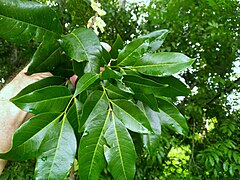| silkwood | |
|---|---|

| |
| Male plant in flower in Cairns | |
| Conservation status | |
| Least Concern (NCA) | |
| Scientific classification | |
| Kingdom: | Plantae |
| Clade: | Tracheophytes |
| Clade: | Angiosperms |
| Clade: | Eudicots |
| Clade: | Rosids |
| Order: | Sapindales |
| Family: | Sapindaceae |
| Genus: | Lepiderema |
| Species: | L. sericolignis |
| Binomial name | |
| Lepiderema sericolignis (F.M.Bailey) Radlk. | |
| Synonyms | |
|
Cupania sericolignis F.M.Bailey | |
Lepiderema sericolignis, commonly known as silkwood, is a plant in the maple and lychee family Sapindaceae found only in the Wet Tropics bioregion of Queensland, Australia.
Description
Lepiderema sericolignis is a small tree to about 4 m (13 ft) high. The compound leaves have 2, 3, or rarely 4 pairs of leaflets that are glossy green above and dull green below. The leaflets are held on very short pulvinate stems about 5 mm (0.20 in) long. They measure up to 16 cm (6.3 in) long and 6 cm (2.4 in) wide and are elliptic in outline, with between 7 and 12 pairs of lateral veins in the blades.
The inflorescences are short spikes about 4.5 cm (1.8 in) long, produced in small clusters on old wood and in the leaf axils. Flowers are either male or female, white to creamy yellow, with 5 petals and measuring about 5 mm (0.20 in) wide. The fruit is a globose, apricot/orange capsule up to 2 cm (0.79 in) long and wide, with three segments each containing a single black seed almost fully enclosed in a yellow aril. The capsules persist on the branches after ripening and dry dark brown or black.
Phenology
Flowering occurs between March and May, and fruit are ripe from August to December.
Taxonomy
This species was first described in 1892 as Cupania sericolignis by the Australian botanist Frederick Manson Bailey. In 1924, the Bavarian botanist Ludwig Adolph Timotheus Radlkofer transferred it to the current genus Lepiderema.
Etymology
The genus name Lepidorema is from the Ancient Greek words lepís meaning a scale or flake, and erêmos meaning "bereft of" or without. It refers to the scale-less petals. The species epithet sericolignis is derived from the Ancient Greek sērikós meaning silky, and the Latin lignis meaning wood, and is a reference to the sheen of the timber.
Distribution and habitat
Lepiderema sericolignis inhabits rainforest, often close to rivers or mangrove communities, from around Rossville southwards to about Ingham. The altitudinal range is from sea level to about 1,000 m (3,300 ft).
Conservation
This species is listed as least concern under the Queensland Government's Nature Conservation Act. As of 23 April 2024, it has not been assessed by the International Union for Conservation of Nature (IUCN).
Gallery
-
 Tree in full flower
Tree in full flower
-
 Foliage
Foliage
-
 Underside of leaves
Underside of leaves
-
 Flower buds, about 2 mm diameter
Flower buds, about 2 mm diameter
-
 Close up of male flowers
Close up of male flowers
References
- ^ "Species profile—Lepiderema sericolignis". Queensland Department of Environment and Science. Queensland Government. 2022. Retrieved 23 April 2024.
- ^ "Lepiderema sericolignis". Australian Plant Name Index (APNI). Centre for Australian National Biodiversity Research, Australian Government. Retrieved 23 April 2024.
- ^ "Lepiderema sericolignis (F.M.Bailey) Radlk". Plants of the World Online. Royal Botanic Gardens, Kew. 2024. Retrieved 23 April 2024.
- ^ Reynolds, S.T. (2022). Busby, J.R.; Kodela, P.G. (eds.). "Lepiderema sericolignis". Flora of Australia. Australian Biological Resources Study, Department of Climate Change, Energy, the Environment and Water: Canberra. Retrieved 23 April 2024.
- ^ F.A.Zich; B.P.M.Hyland; T.Whiffen; R.A.Kerrigan (2020). "Lepiderema sericolignis". Australian Tropical Rainforest Plants Edition 8 (RFK8). Centre for Australian National Biodiversity Research (CANBR), Australian Government. Retrieved 23 April 2024.
- ^ Reynolds, S.T. (1982). "Notes on Sapindaceae in Australia, II". Austrobaileya. 1 (5): 490. JSTOR 41738633.
- ^ Cooper, Wendy; Cooper, William T. (June 2004). Fruits of the Australian Tropical Rainforest. Clifton Hill, Victoria, Australia: Nokomis Editions. p. 494. ISBN 978-0958174213.
- "Lepiderema sericolignis (Silkwood)". iNaturalist. Retrieved 23 April 2024.
- "Cupania sericolignis". International Plant Names Index (IPNI). Royal Botanic Gardens, Kew. 2024. Retrieved 23 April 2024.
- "Search: species: Lepiderema sericolignis | Occurrence records". Australasian Virtual Herbarium. Australian Government. Retrieved 23 April 2024.
Notes
- Phenology information from iNaturalist is based on a total of 21 observations as at 23 April 2024. Data are shown under the "Plant phenology" tab in the referenced page.
External links
- View a map of herbarium collections of this species at the Australasian Virtual Herbarium
- View observations of this species on iNaturalist
- View images of this species on Flickriver.com
| Taxon identifiers | |
|---|---|
| Lepiderema sericolignis |
|
| Cupania sericolignis | |